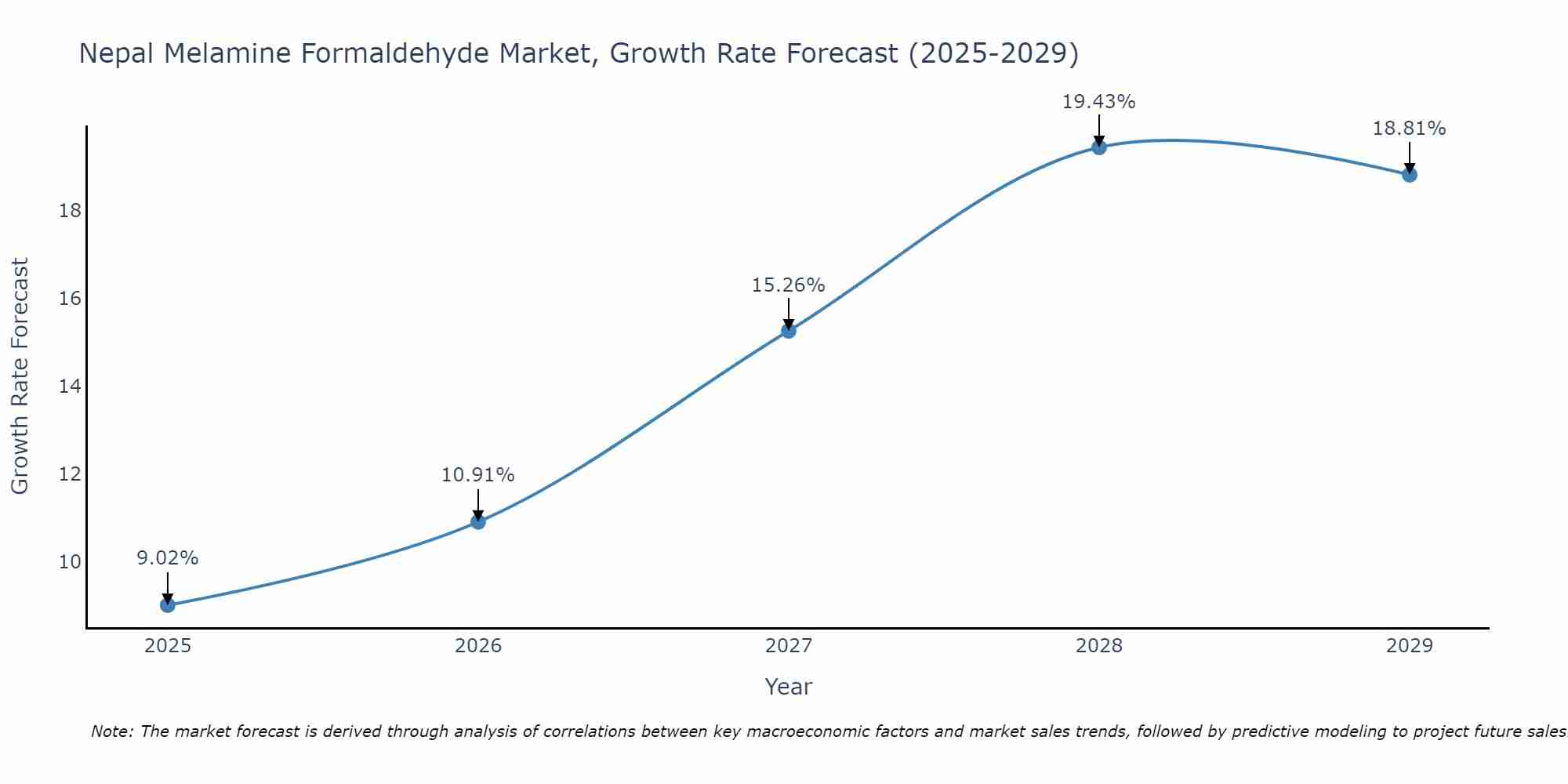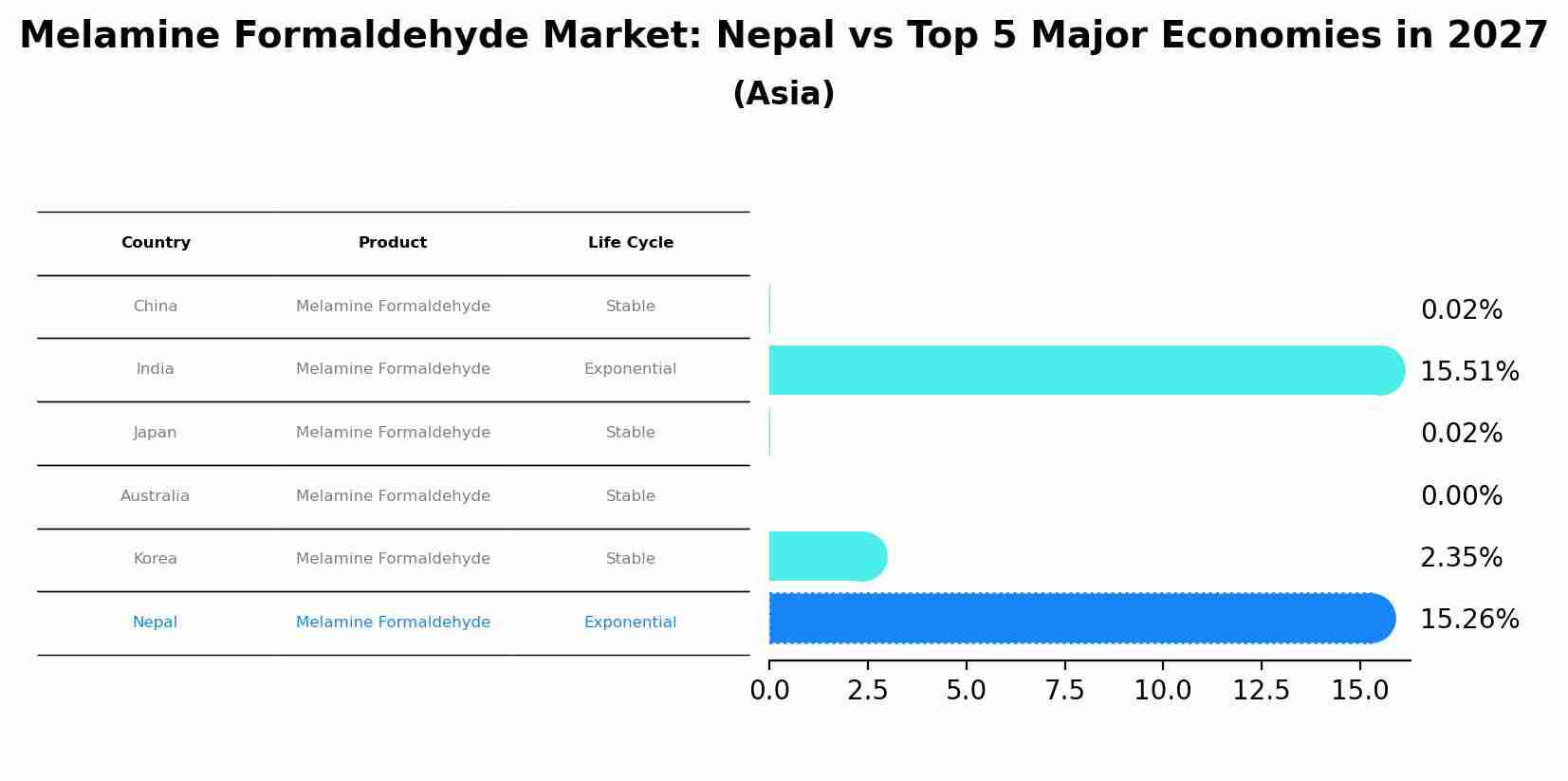Nepal Melamine Formaldehyde Market (2025-2031) Outlook | Forecast, Size, Revenue, Growth, Share, Trends, Industry, Companies, Analysis & Value
| Product Code: ETC110155 | Publication Date: Jun 2021 | Updated Date: Jun 2025 | Product Type: Report | |
| Publisher: 6Wresearch | Author: Summon Dutta | No. of Pages: 70 | No. of Figures: 35 | No. of Tables: 5 |
Nepal Melamine Formaldehyde Market Size Growth Rate
The Nepal Melamine Formaldehyde Market is projected to witness mixed growth rate patterns during 2025 to 2029. Starting at 9.02% in 2025, the market peaks at 19.43% in 2028, and settles at 18.81% by 2029.

Melamine Formaldehyde Market: Nepal vs Top 5 Major Economies in 2027 (Asia)
By 2027, the Melamine Formaldehyde market in Nepal is anticipated to reach a growth rate of 15.26%, as part of an increasingly competitive Asia region, where China remains at the forefront, supported by India, Japan, Australia and South Korea, driving innovations and market adoption across sectors.

Nepal Melamine Formaldehyde Market Overview
The Nepal Melamine Formaldehyde market is experiencing steady growth due to the increasing demand for melamine formaldehyde resins in construction, automotive, and electrical industries. These resins are widely used in laminates, adhesives, coatings, and molding compounds due to their excellent heat resistance, hardness, and chemical resistance properties. The market is driven by the growing construction sector in Nepal, leading to higher demand for melamine formaldehyde-based products for decorative laminates and furniture. Additionally, the automotive industry`s expansion is fueling the market as melamine formaldehyde resins are utilized in manufacturing durable and lightweight automotive components. Key players in the Nepal Melamine Formaldehyde market include companies like BASF SE, Hexion Inc., and Chemiplastica SA, focusing on product innovation and strategic partnerships to maintain their market presence.
Nepal Melamine Formaldehyde Market Trends
The Nepal Melamine Formaldehyde Market is experiencing steady growth driven by the increasing demand for melamine formaldehyde resins in the construction and furniture industries. The market is witnessing a rise in the use of melamine formaldehyde resins due to their excellent properties such as high heat resistance, durability, and water resistance. Additionally, the growing awareness about the benefits of using melamine formaldehyde in manufacturing decorative laminates and coatings is contributing to the market`s expansion. With the construction sector booming and the rise in infrastructure development projects in Nepal, the demand for melamine formaldehyde is expected to continue to grow. Manufacturers are focusing on product innovation and technological advancements to meet the evolving needs of the market, further fueling the growth of the Nepal Melamine Formaldehyde Market.
Nepal Melamine Formaldehyde Market Challenges
In the Nepal Melamine Formaldehyde market, some of the key challenges include limited awareness and understanding of the product among consumers and manufacturers, leading to a relatively small market size compared to other regions. Additionally, the lack of standardized regulations and quality control measures in the industry poses a challenge in ensuring the safety and quality of melamine formaldehyde products. Supply chain inefficiencies and unstable raw material prices also impact the market, making it difficult for manufacturers to maintain consistent production and pricing strategies. Furthermore, competition from alternative materials and substitutes in the market adds pressure on melamine formaldehyde producers to differentiate their products and demonstrate their value proposition to potential customers in Nepal.
Nepal Melamine Formaldehyde Market Investment Opportunities
The Nepal Melamine Formaldehyde market presents promising investment opportunities due to the growing demand for melamine-based products in various industries such as construction, packaging, automotive, and electronics. With the increasing focus on eco-friendly and sustainable materials, melamine formaldehyde resins are being preferred for their durability, heat resistance, and low toxicity. Investing in manufacturing facilities for melamine formaldehyde resins or partnering with existing manufacturers in Nepal can be lucrative. Additionally, there is potential for developing innovative products using melamine formaldehyde, such as kitchenware, tableware, and laminates, to cater to the domestic market and potentially expand into exports. Conducting thorough market research, understanding consumer preferences, and establishing strategic partnerships will be key to capitalizing on the investment opportunities in the Nepal Melamine Formaldehyde market.
Nepal Melamine Formaldehyde Market Government Policy
The Nepal government has implemented strict regulations and standards regarding the usage of melamine formaldehyde in products to ensure consumer safety and environmental protection. The government has set limits on the amount of melamine formaldehyde that can be used in various products such as tableware, kitchenware, and sanitary products. Additionally, the government conducts regular inspections and testing to ensure compliance with these regulations. Importers and manufacturers are required to obtain necessary permits and certifications to ensure the quality and safety of their products. The government also promotes research and development in the field of alternative materials to reduce reliance on melamine formaldehyde. Overall, the government`s policies aim to safeguard public health and the environment while promoting sustainable practices in the Nepal Melamine Formaldehyde Market.
Nepal Melamine Formaldehyde Market Future Outlook
The Nepal Melamine Formaldehyde market is expected to witness steady growth in the coming years, driven by increasing demand from the construction, automotive, and electronics industries. The growing focus on sustainable and eco-friendly materials, coupled with the rising awareness about the benefits of melamine formaldehyde in improving product durability and performance, will further drive market expansion. Additionally, government initiatives to promote infrastructure development and the growing consumer preference for high-quality and aesthetically pleasing products are expected to boost market demand. However, challenges such as fluctuating raw material prices and the availability of substitutes may hinder market growth to some extent. Overall, the Nepal Melamine Formaldehyde market is poised for growth opportunities, especially as industries increasingly prioritize quality and efficiency in their products.
Key Highlights of the Report:
- Nepal Melamine Formaldehyde Market Outlook
- Market Size of Nepal Melamine Formaldehyde Market, 2021
- Forecast of Nepal Melamine Formaldehyde Market, 2031
- Historical Data and Forecast of Nepal Melamine Formaldehyde Revenues & Volume for the Period 2021 - 2031
- Nepal Melamine Formaldehyde Market Trend Evolution
- Nepal Melamine Formaldehyde Market Drivers and Challenges
- Nepal Melamine Formaldehyde Price Trends
- Nepal Melamine Formaldehyde Porter's Five Forces
- Nepal Melamine Formaldehyde Industry Life Cycle
- Historical Data and Forecast of Nepal Melamine Formaldehyde Market Revenues & Volume By Type for the Period 2021 - 2031
- Historical Data and Forecast of Nepal Melamine Formaldehyde Market Revenues & Volume By Methylated Melamine Formaldehyde Resin for the Period 2021 - 2031
- Historical Data and Forecast of Nepal Melamine Formaldehyde Market Revenues & Volume By Non-methylated Melamine Formaldehyde Resin for the Period 2021 - 2031
- Historical Data and Forecast of Nepal Melamine Formaldehyde Market Revenues & Volume By Application for the Period 2021 - 2031
- Historical Data and Forecast of Nepal Melamine Formaldehyde Market Revenues & Volume By Laminates for the Period 2021 - 2031
- Historical Data and Forecast of Nepal Melamine Formaldehyde Market Revenues & Volume By Wood Adhesives for the Period 2021 - 2031
- Historical Data and Forecast of Nepal Melamine Formaldehyde Market Revenues & Volume By Molding Compounds for the Period 2021 - 2031
- Historical Data and Forecast of Nepal Melamine Formaldehyde Market Revenues & Volume By Paints and Coatings for the Period 2021 - 2031
- Historical Data and Forecast of Nepal Melamine Formaldehyde Market Revenues & Volume By Other Applications for the Period 2021 - 2031
- Nepal Melamine Formaldehyde Import Export Trade Statistics
- Market Opportunity Assessment By Type
- Market Opportunity Assessment By Application
- Nepal Melamine Formaldehyde Top Companies Market Share
- Nepal Melamine Formaldehyde Competitive Benchmarking By Technical and Operational Parameters
- Nepal Melamine Formaldehyde Company Profiles
- Nepal Melamine Formaldehyde Key Strategic Recommendations
Frequently Asked Questions About the Market Study (FAQs):
- Single User License$ 1,995
- Department License$ 2,400
- Site License$ 3,120
- Global License$ 3,795
Search
Thought Leadership and Analyst Meet
Our Clients
Related Reports
- Canada Oil and Gas Market (2026-2032) | Share, Segmentation, Value, Industry, Trends, Forecast, Analysis, Size & Revenue, Growth, Competitive Landscape, Outlook, Companies
- Germany Breakfast Food Market (2026-2032) | Industry, Share, Growth, Size, Companies, Value, Analysis, Revenue, Trends, Forecast & Outlook
- Australia Briquette Market (2025-2031) | Growth, Size, Revenue, Forecast, Analysis, Trends, Value, Share, Industry & Companies
- Vietnam System Integrator Market (2025-2031) | Size, Companies, Analysis, Industry, Value, Forecast, Growth, Trends, Revenue & Share
- ASEAN and Thailand Brain Health Supplements Market (2025-2031) | Strategy, Consumer Insights, Analysis, Investment Trends, Opportunities, Growth, Size, Share, Industry, Revenue, Segments, Value, Segmentation, Supply, Forecast, Restraints, Outlook, Competition, Drivers, Trends, Demand, Pricing Analysis, Competitive, Strategic Insights, Companies, Challenges
- ASEAN Bearings Market (2025-2031) | Strategy, Consumer Insights, Analysis, Investment Trends, Opportunities, Growth, Size, Share, Industry, Revenue, Segments, Value, Segmentation, Supply, Forecast, Restraints, Outlook, Competition, Drivers, Trends, Demand, Pricing Analysis, Competitive, Strategic Insights, Companies, Challenges
- Europe Flooring Market (2025-2031) | Outlook, Share, Industry, Trends, Forecast, Companies, Revenue, Size, Analysis, Growth & Value
- Saudi Arabia Manlift Market (2025-2031) | Outlook, Size, Growth, Trends, Companies, Industry, Revenue, Value, Share, Forecast & Analysis
- Uganda Excavator, Crane, and Wheel Loaders Market (2025-2031) | Strategy, Consumer Insights, Analysis, Investment Trends, Opportunities, Growth, Size, Share, Industry, Revenue, Segments, Value, Segmentation, Supply, Forecast, Restraints, Outlook, Competition, Drivers, Trends, Demand, Pricing Analysis, Competitive, Strategic Insights, Companies, Challenges
- Rwanda Excavator, Crane, and Wheel Loaders Market (2025-2031) | Strategy, Consumer Insights, Analysis, Investment Trends, Opportunities, Growth, Size, Share, Industry, Revenue, Segments, Value, Segmentation, Supply, Forecast, Restraints, Outlook, Competition, Drivers, Trends, Demand, Pricing Analysis, Competitive, Strategic Insights, Companies, Challenges
Industry Events and Analyst Meet
Whitepaper
- Middle East & Africa Commercial Security Market Click here to view more.
- Middle East & Africa Fire Safety Systems & Equipment Market Click here to view more.
- GCC Drone Market Click here to view more.
- Middle East Lighting Fixture Market Click here to view more.
- GCC Physical & Perimeter Security Market Click here to view more.
6WResearch In News
- Doha a strategic location for EV manufacturing hub: IPA Qatar
- Demand for luxury TVs surging in the GCC, says Samsung
- Empowering Growth: The Thriving Journey of Bangladesh’s Cable Industry
- Demand for luxury TVs surging in the GCC, says Samsung
- Video call with a traditional healer? Once unthinkable, it’s now common in South Africa
- Intelligent Buildings To Smooth GCC’s Path To Net Zero


















